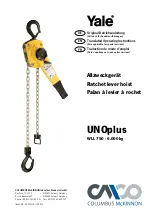
OPERATING INSTRUCTIONS
CHAIN SLINGS GRADES 80 AND 100
THIELE GmbH & Co. KG
# Change indicator
www.thiele.de | [email protected]
B11082-C
replaces B11082-B
© All rights reserved.
US 01.2020
7 | 11
6.
ASSEMBLY AND REMOVAL
6.1
Preparations
All components to be installed or used must be in perfect
condition and the relevant Working Load Limits of all parts
must accommodate the respective load to be handled.
6.2
Chain Assembly
When assembling or disassembling chain slings the relevant
assembly and Operating Instructions issued for the
components must be observed.
6.3
Clevis Fastening System
The clevis fastening system only
permits attachment of the nominal
chain size that suits the attachment
component.
6.3.1
ASSEMBLY
•
If necessary, remove dowel pin
and pin.
•
(A) Place end of chain leg
between the lateral clevis
elements.
•
(B) Push pin from the side fully into the clevis and through
the last chain link of the leg.
•
(C) Drive dowel pin fully in (must not project) to secure the
pin. The slot must face away from the pin.
Check whether the chain runs smoothly.
The dowel pins must only be installed once.
Only connect pins and attachment components of identical
grades
. Starting with Ø ½”
the pins are marked on the front
end.
6.3.2
DISASSEMBLY
•
Slacken the respective chain leg.
•
(A) Drive dowel pin out using
hammer and drift punch
1)
.
•
(B) Push pin out using a drift
punch.
•
(C) Remove the chain.
1)
Suitable drift punches are available by Article No. Z03303.
7.
CONDITIONS OF USE
7.1
Normal Use
When 4-leg chain slings are used there is a risk that the load
will act on two oppositely located chain legs only. In such a
case, check the Working Load Limit of the sling chain assembly
and use an assembly that has a higher Working Load Limit.
Shortening individual chain legs is indicative of a non-
symmetrical load distribution. In this case, the Working Load
Limit must be reduced.
If choke hitch applications are involved the Working Load Limit
is to be additionally reduced by 20 %.
When using hooks without safety latch, e.g. due to operational
necessities, special care is to be taken, and a separate risk
analysis must be carried out before operation.
When attaching components, observe the correct position of the
connecting links.
Relevant forces must act in longitudinal direction.
If two chain legs are assembled into one connecting link half for
alternate use of the legs, only one chain leg must be subjected to
loads!
If not all chain legs in a multi-leg sling chain assembly are used,
the Working Load Limit is to be reduced according to the
following table:
Total number of
legs
Number of legs to
be put to use
Use factor
relevant to WLL
specified
2
1
1/2
3 or 4
2
2/3
3 or 4
1
1/3


















